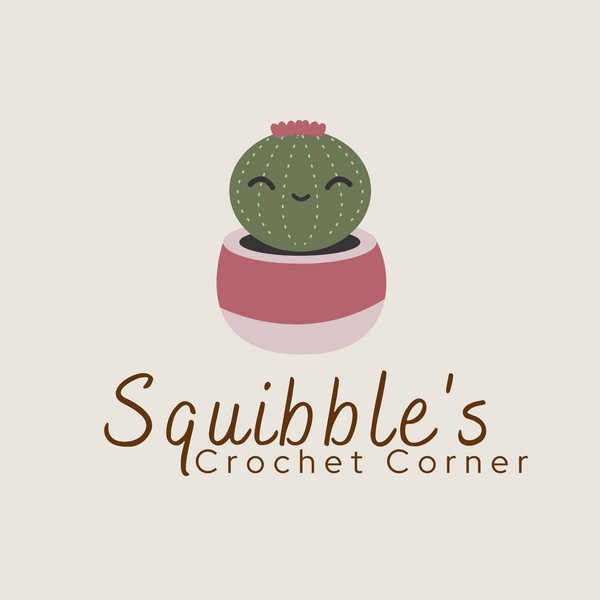Making crochet flowers and plants is super fun, but it can get a little tricky, especially when you’re trying to keep everything stable. Finding the right balance between looking good and staying sturdy takes some attention. Getting the tension just right while you’re working is important, but how do you make sure your project looks awesome for a long time? I’ve put together some handy tips that can really boost your next plant project. These are the tricks I use all the time, and they really work!
Pin it to Save it for Later!
Inserts
Problem: The bottom of the crocheted plant is uneven and topples over easily.
Solution: Cardboard or wooden circle placed to fit the bottom of the pot, then add stuffing.
It's almost impossible to achieve a completely flat surface at the bottom of crocheted pots due to the nature of the stitches and stuffing. A simple way to add extra stability to the base of your crochet pots is to include a cut-out piece of cardboard or a fitted wooden circle before adding the stuffing. This technique helps create a flatter surface, reducing the likelihood of the pot tipping over.
Most of us have cardboard boxes or scraps around the house. Instead of discarding them, consider reusing them in your crochet plants! Simply trace the bottom of the pot onto the cardboard, cut it out with scissors, and trim as necessary to ensure it fits snugly at the bottom.
If you don't have any cardboard, you can also find various sizes of wooden circles to use as a base for your crocheted pot. Just measure the bottom of your pot and choose a wooden circle that best fits its dimensions.

Weighted Base
Problem: Easily knocked over and top-heavy crochet plant.
Solution: Add some weight to your pot with poly pellets, beans, or glass beads.
I learned this lesson the hard way at outdoor craft shows: any little gust of wind would knock over my crochet plants. I realized that I needed to find a way to add more weight to them, as the yarn and stuffing alone weren't sufficient. The simplest solution was to add weight to the pot.
My goal was to find a material that would add weight without distorting the shape of the pot. This led to my idea of using poly pellets. Poly pellets are small plastic beads specifically designed to add weight to various projects.
Watch While You Crochet!!
Typically, my process for incorporating poly pellets into my potted crochet plants begins with placing an insert or a cardboard base in the pot (see the Inserts description above for more details). Depending on the size of your pot, pour a layer of poly pellets about 0.5 to 1 inch (1 to 3 cm) deep at the bottom. After that, add your polyfill stuffing before finishing off the pot. This method creates the perfect amount of weight to keep your potted plants stable!
If you want more eco-friendly options, consider using small beans or glass beads instead of poly pellets.

Adding Wire
Problem: Leaves or petals that are floppy and fall over.
Solution: Floral wire crocheted around the edge of the leaf/petals.
If you have ever crocheted a leafy plant, you probably know how easy it is for the leaves to droop. Simply put, most yarn isn’t strong enough to hold its shape. A little 22-gauge floral wire can easily solve this problem! Instead of crocheting your leaves or, in some cases, the petals of a flower solely with yarn, you can crochet some floral wire into your leaves or petals to add stability and make it easier to shape them as you desire.
The Mini Spider and Mini Snake plants from the Mini House Plant Collection crochet pattern are perfect examples of how to apply this technique. Before crocheting the exterior of the leaves, wrap a piece of 22-gauge floral wire around each leaf, shaping it to match the leaf's form. Cut the floral wire, leaving about a 1-inch (2.5 cm) piece of wire on either side of the leaf (photo 1). While holding the floral wire in place around the leaf, insert your hook into the designated stitch at the base of the leaf and yarn over, pulling a loop through the stitch (photo 2). Yarn over again and complete the designated stitch according to your pattern, ensuring the floral wire is included between the stitches (photo 3). Continue this technique around the entire edge of the leaf (photo 4).

Problem: Main piece/stem that is top-heavy.
Solution: Pipe cleaners or floral wire inside the crocheted stem.
If you're crocheting a stem for your flowers, you may notice that the flower is top-heavy, which can make the piece look unbalanced. Before you finish crocheting the stem, consider adding a few pipe cleaners or floral wire inside to provide more structure and make it easier to manipulate.
I use this technique in both the Sunflower Buddy and Mini Sunflower Buddy crochet patterns. After I crochet the stem, I fold a couple of white pipe cleaners in half and insert them into the stem. Once the piece is finished, the flower's stem stands much straighter and allows me to customize the direction in which the flower faces.

Use of Different Pots
Problem: You are worried even with all the above solutions, your plant may still need some added stability.
Solution: Achieve the ultimate level of stability with ceramic pots or terra cotta pots.
Perhaps a crocheted pot isn't the best option. There are many decorative and fun pots available that you can use to crochet around your plants. For instance, the Valentine’s Cactus crochet pattern utilizes a small ceramic pot instead of a less stable crocheted one. Not only are you saving time by using a ceramic or terra cotta pot, you are exponentially increasing your crochet plant's stability.

Which of these tips have you used before or is the most helpful? Let me know in the comments below!
FTC Disclaimer: This blog post contains affiliate links, meaning when items are purchased through those links, I receive a small commission. Thank you for supporting me and my business!


